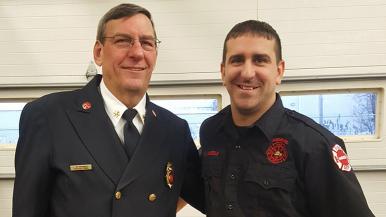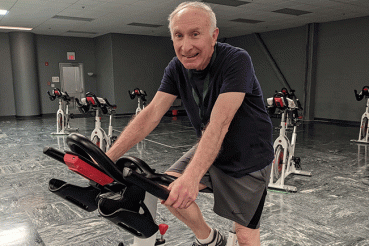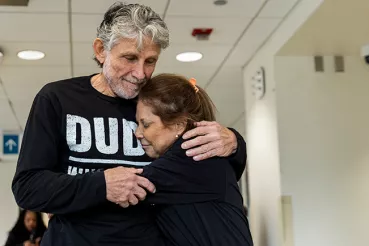As a volunteer firefighter for 33 years, Marty Michels didn’t hesitate to run toward burning buildings and other dangerous situations. But last spring, Marty’s courage was put to the test when he learned he had a rare type of tumor at the base of his skull.
The 67-year-old retired electrician from Griffith, Indiana, had suspicious headaches and neck pain that would come and go beginning in December 2021. “It felt like someone was poking me with a dull knife on the back of head, behind my right ear,” Marty says. Eventually, the pain became more severe. “It felt like my head was going to explode,” he says.
After Marty had a magnetic resonance imaging, or MRI, test at his local hospital the following April, he learned he had a rare type of tumor in his skull called a clival chordoma that would need to be removed during a complex operation. “The neurosurgeon there told me they were not equipped to handle that type of surgery,” Marty says. “He told me that RUSH was the place to go, and he was right.”
Understanding clival chordomas
Chordomas are bone tumors that slowly develop in the spine or an area at the base of the skull called the clivus. Marty had a chordoma in the clivus — a condition so rare that only about one in a million people are affected, says Stephan Munich, MD, Marty’s neurosurgeon and director of skull base neurosurgery at RUSH. Men are twice as likely to get chordomas as women, and most occur in people between ages 40 and 70.
The tumor inside Marty’s clival bone at the base of his skull was about the size of a small lime and was pushing on his brainstem — the vital structure that connects the brain to the spinal cord. And like most skull base tumors, the chordoma was close to Marty’s brain as well as nerves involved in swallowing and major blood vessels, making it especially challenging to treat.
Sometimes, it is necessary to perform two operations to remove a clival chordoma of this size: the first to remove part of the tumor through the nose, and the second to remove the remaining portion with a craniotomy, a more invasive procedure that requires creating an opening in the skull. But thanks to the skill and teamwork of RUSH’s comprehensive skull base surgery team, which includes doctors from more than 10 specialties, Marty’s entire tumor could be removed through his nose during a single operation.
Skull base surgery without a craniotomy
The evening Marty learned he had a clival chordoma, he was taken by ambulance from his local hospital to RUSH for treatment.
At RUSH, Marty had a specialized MRI so the surgical team would have a “map” of Marty’s head and neck to guide them during the surgery. In a complex procedure, Munich and Peter Papagiannopoulos, MD, a rhinologist and skull base surgeon at RUSH, removed the entire chordoma through Marty’s nose using a thin tube and special surgical instruments.
First, Papagiannopoulos created a pathway in Marty’s sinuses for Munich to access the tumor. Then, Munich used stereotactic navigation — essentially a “global positioning system” for surgeons — to reach the tumor in the clival bone without damaging critical structures.
After Munich removed the tumor in the clival bone, he took out part of the tumor that had invaded the tissue surrounding Marty’s brain and spinal cord, taking care not to damage delicate blood vessels and cranial nerves that control tongue movement, swallowing and other functions. Then, Papagiannopoulos reconstructed part of the skull base that had been removed because of the tumor. Specifically, he rebuilt the barrier that separates the brainstem and spinal cord from the area behind the nose and mouth called the pharynx. To do this, he used a technique called a nasoseptal flap, utilizing part of the septum that divides the nasal passages. He also used tissue from Marty’s thigh to recreate the barrier.
In all, the surgery took about 11 hours. When Marty woke up, the headache and neck pain were gone. If the surgeons had not been able to remove the entire tumor through Marty’s nose, they would have had to perform a craniotomy. This would have involved removing an area of his skull about two inches in diameter to get the remaining portion of the tumor.
A week after the tumor was removed, Marty had an occipitocervical fusion performed by Ricardo Fontes, MD, a neurosurgeon specializing in spine and back care at RUSH, to stabilize the top part of his spine. During this procedure, Fontes placed special screws at the base of Marty’s skull and in the top three vertebrae in his neck, which had been opened to remove the tumor. He also used a bone graft from one of Marty’s ribs to help new bone grow to support the area.
Expert care plus a positive attitude
After the fusion, Marty remained at RUSH for about three weeks to begin his recovery. Jane, his wife of 45 years, visited him every day. “She was my rock,” he says. His three adult children and five grandchildren also offered their love and support. His brother, Floyd, flew in from Florida and also visited him every day to provide encouragement and keep Marty’s spirits up.
The surgeons also kept close tabs on Marty. “Every day I was in the hospital, at least one member or multiple members of the surgical team would stop in to check up on me. They would always explain what the next step was or answer any questions that I had,” Marty says.
Looking back on that difficult month, Marty is grateful for the many specialists at RUSH who worked together to treat his chordoma. “I can never say enough about Dr. Munich, Dr. Papagiannopoulos, Dr. Fontes and each and every member of the surgical teams that performed the surgeries on me,” Marty says. “They are the best.”
Marty also appreciated the attention he received from other members of the RUSH team. “RUSH provided the best care to me — not just the nursing staff, but the housekeeping and food service staff were also very accommodating,” he says.
Besides the support he received from his family and his care team, other factors that helped Marty were his sense of humor and optimistic outlook, his lead surgeon says. “Marty had two very big surgeries, and throughout his hospital stay he kept a really positive attitude, which allowed him to recover more completely and more rapidly than might be expected,” Munich says.
While it was the collaborative approach of RUSH’s skull base team that helped Marty avoid the craniotomy, he also likes to joke that other factors were at play. “Fortunately, I have a big nose,” Marty says. When Marty shared this with Munich, the neurosurgeon offered his own perspective: “I told him that all the teasing he went through at school was worth it.”
A hopeful recovery
After Marty returned home to Griffith, he used a walker for a week while he regained his strength. Then he used a cane for several weeks until he felt stable walking again.
Today, the longtime Jimmy Buffett fan says he can do “anything my wife lets me do,” including driving and cutting the grass. “I’m feeling good now, just a little sore on the side of my neck from time to time, depending on what I’m doing,” he says. On a typical day, Marty often gets in more than 10,000 steps by taking walks around the park with Jane and their rescue dog, a black Lab mix named Coco.
Marty recently began radiation therapy at another hospital to eliminate any potential tumor cells that could remain. This is recommended for patients with chordomas to reduce the risk that the tumor returns.
When his radiation is complete, Marty plans to return to volunteering at a camp for Scouts and see his family in Florida over the holidays this year. He also hopes to start working again on a 1973 Gran Torino he acquired last fall before he started having headaches. “I’m looking forward to getting back out in the garage again,” he says.
RUSH University Medical Center is ranked among the best in the nation for neurology and neurosurgery. Find out more about our skull base and pituitary surgery services.




